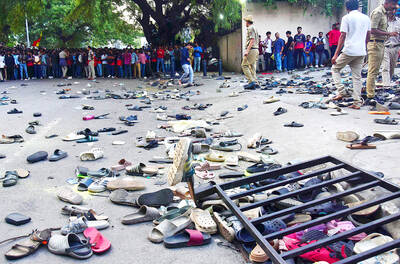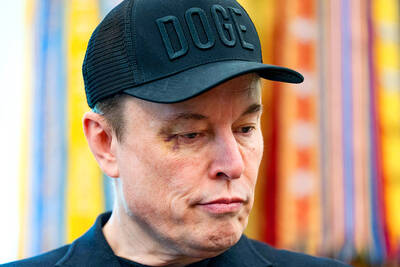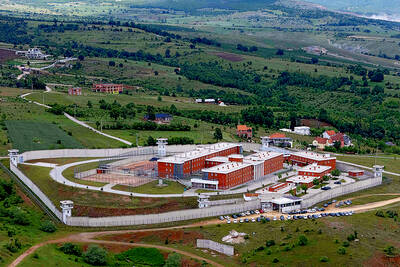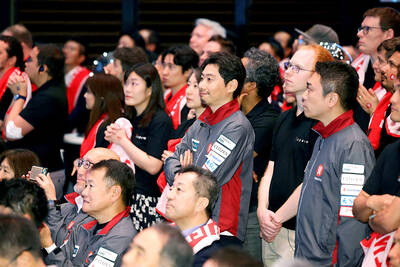Singapore extended support for older workers in the aging island nation, as the current leadership prepares to hand over to a new generation in coming years.
The retirement age is to be gradually raised to 65 from 62, Singaporean Prime Minister Lee Hsien Loong (李顯龍) said on Sunday in his annual National Day Rally speech.
The re-employment age, where employers must offer work in the same organization, is to rise to 70 from 67.
The city-state will also increase pension-contribution rates for workers so that by 2030, any worker age 60 or below will get the full rate, Lee said.
The government is looking ahead to elections that must be held by 2021, while Lee is preparing to hand power to new leaders “in the next few years.”
The measures build on support Lee’s government already is giving to older citizens, including S$6.1 billion (US$4.4 billion) it set aside this year for a fund that includes subsidized healthcare for those in their 60s.
The pledges come as the trade-dependent nation grapples with fears of a global recession and an intensifying rivalry between its two biggest trading partners.
In the past week, the government slashed its economic outlook for this year to a range of zero to 1 percent growth, predicting what could be its most sluggish year in a decade.
The government is to help businesses adjust to higher costs associated with the pension changes, as employers are required to match their staff’s retirement fund contributions.
Singaporeans now have the longest life expectancy in the world at nearly 85 years, Lee said in his speech, adding that there are 1,300 centenarians among a population of less than 6 million.
Singaporean Minister of Manpower Josephine Teo in March said that a higher retirement age would encourage workers and employers to invest in upgrading skills and adapting jobs for older workers. Raising the re-employment age aims to give companies more flexibility to reset work terms — like salary and job scope — to deal with business uncertainties.
Lee also emphasized the threat low-lying Singapore faces from climate change.
It could cost S$100 billion or more over the next century to prepare the country to deal with rising sea levels, hotter temperatures and more intense rainfall, Lee said, adding that the effort was as critical as military defense to the nation’s survival.
“Everything else must bend at the knee to safeguard the existence of our island nation,” Lee said. “With climate change, we know for sure that sea levels will rise.”
All new developments will have to be built on platforms at least 4m above sea level, while critical infrastructure like the upcoming airport terminal and port must be built at least 5m above sea level, Lee said.
With almost one-third of the country lying just 5m above sea level, the government will also consider options such as building polders to protect existing low-lying areas — a solution employed in the Netherlands — and reclaiming land for offshore islands, Lee said.
The focus on climate change is a natural evolution from the priorities espoused by Singapore’s founding leader —Lee Kuan Yew (李光耀)— who ensured that the city-state was flush with greenery and that its design allowed residents to use underground passages to avoid the blistering heat and tropical downpours.
The government last month announced that it would invest S$400 million over the next two years to upgrade drainage systems. That would add to the S$1.8 billion already spent since 2011 to boost flood resilience, Singaporean Minister for the Environment and Water Resources Masagos Zulkifli said.

Packed crowds in India celebrating their cricket team’s victory ended in a deadly stampede on Wednesday, with 11 mainly young fans crushed to death, the local state’s chief minister said. Joyous cricket fans had come out to celebrate and welcome home their heroes, Royal Challengers Bengaluru, after they beat Punjab Kings in a roller-coaster Indian Premier League (IPL) cricket final on Tuesday night. However, the euphoria of the vast crowds in the southern tech city of Bengaluru ended in disaster, with Indian Prime Minister Narendra calling it “absolutely heartrending.” Karnataka Chief Minister Siddaramaiah said most of the deceased are young, with 11 dead

DENIAL: Musk said that the ‘New York Times was lying their ass off,’ after it reported he used so much drugs that he developed bladder problems Elon Musk on Saturday denied a report that he used ketamine and other drugs extensively last year on the US presidential campaign trail. The New York Times on Friday reported that the billionaire adviser to US President Donald Trump used so much ketamine, a powerful anesthetic, that he developed bladder problems. The newspaper said the world’s richest person also took ecstasy and mushrooms, and traveled with a pill box last year, adding that it was not known whether Musk also took drugs while heading the so-called US Department of Government Efficiency (DOGE) after Trump took power in January. In a

By 2027, Denmark would relocate its foreign convicts to a prison in Kosovo under a 200-million-euro (US$228.6 million) agreement that has raised concerns among non-governmental organizations (NGOs) and residents, but which could serve as a model for the rest of the EU. The agreement, reached in 2022 and ratified by Kosovar lawmakers last year, provides for the reception of up to 300 foreign prisoners sentenced in Denmark. They must not have been convicted of terrorism or war crimes, or have a mental condition or terminal disease. Once their sentence is completed in Kosovan, they would be deported to their home country. In

LOST CONTACT: The mission carried payloads from Japan, the US and Taiwan’s National Central University, including a deep space radiation probe, ispace said Japanese company ispace said its uncrewed moon lander likely crashed onto the moon’s surface during its lunar touchdown attempt yesterday, marking another failure two years after its unsuccessful inaugural mission. Tokyo-based ispace had hoped to join US firms Intuitive Machines and Firefly Aerospace as companies that have accomplished commercial landings amid a global race for the moon, which includes state-run missions from China and India. A successful mission would have made ispace the first company outside the US to achieve a moon landing. Resilience, ispace’s second lunar lander, could not decelerate fast enough as it approached the moon, and the company has